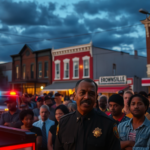Brownsville Water Services Restored After Line Break
In a relieving update for Valley residents, water services have been restored in Brownsville following a significant disruption caused by a damaged water line. The incident, which initially affected 50 households in the downtown area near 9th and Monroe Street, underscored the ongoing challenges Brownsville faces with its aging utility infrastructure.
A Swift Resolution to the Crisis
The water line break occurred on Wednesday evening when a contractor from Lit Fiber damaged an underground pipe. The disruption left residents in the affected area grappling with a sudden loss of essential water supply. Fortunately, the Brownsville Public Utilities Board managed to restore water services by Thursday afternoon, offering relief to the affected households.
Lucila Cantu Gonzalez, a local resident, expressed her relief upon the restoration of water service. “Que bueno, we need it, we use it for everything,” Gonzalez stated, emphasizing the critical role of water in daily life.
Understanding the Underlying Issues
This recent incident draws attention to broader systemic issues within Brownsville’s infrastructure. According to Brownsville District 3 Commissioner Roy De Los Santos, the problem is not uncommon in the city’s older neighborhoods. He remarked, “What has been happening lately is that the company brought in to mark where the utilities are before the fiber goes in relies on maps that are very old and probably outdated by now.”
De Los Santos acknowledged that while there are discussions among city leaders about updating these outdated utility maps, concrete plans are not yet in place. This leaves the possibility of future disruptions looming over residents as long as the current mapping system remains unchanged.
Impact on the Rio Grande Valley
For the Rio Grande Valley community, such infrastructure issues present not just localized inconveniences but broader implications for development and quality of life. The reliance on old mapping systems reflects a scenario common in various parts of South Texas, where rapid development and infrastructural expansion often outpace the updating of essential systems.
Local infrastructure expert, Dr. Alejandro Marquez, notes, “In the Valley, where growth is fast-paced, especially in urban and suburban areas, keeping infrastructure up-to-date is crucial to avoid disruptions that can hamper daily life and local business activities.”
Connecting to Past Challenges
Water line breaks and similar service interruptions are not new to Brownsville or the greater RGV. In recent years, similar incidents have highlighted the need for comprehensive infrastructural reviews and proactive measures from city managers and local governments. Such efforts are essential to minimize the frequency and severity of service disruptions, especially in older parts of cities.
The situation echoes a wider narrative witnessed across South Texas, where the balance between modernization and maintaining existing infrastructure demands careful consideration and planning.
Looking Forward: Future Implications
Moving forward, Brownsville residents and city officials face the task of addressing these outdated utility systems head-on. There is potential for turning the current setback into an opportunity for long-term improvement.
“Infrastructure is no longer just about patchwork fixes but about looking at comprehensive solutions that safeguard against future disruptions,” Dr. Marquez explains, suggesting that Brownsville can lead by example in addressing these challenges creatively and effectively.
Moreover, the incidents raise significant questions about contractor accountability and the systems in place to prevent such occurrences. The role of the city in ensuring contractors adhere to safe and effective practices is critical in safeguarding communal services.
Tackling Different Perspectives
Opinions on addressing the issue vary, with some emphasizing immediate fixes and others advocating for sweeping infrastructural reform. While quick responses to incidents are essential, these must work in tandem with broader strategies to ensure long-term resiliency.
“We need to put systems in place that prevent such crises, but this requires investment and political will,” Commissioner De Los Santos highlights, pointing out the complex interplay of resources, political dynamics, and community advocacy.
Resources and Contacts for the Community
To assist residents, the Brownsville Public Utilities Board maintains a hotline and online platform for reporting incidents and seeking assistance. Community forums and sessions initiated by city officials are also avenues for residents to share feedback and stay informed on developments.
As Valley residents continue to navigate these challenges, the commitment to improvement and collaboration across Brownsville’s community offers a pathway to resilience. While the water line break posed immediate challenges, it also underscores a broader push towards sustainability and progress within South Texas’s cities. The situation not only highlights current challenges but also sets the stage for future innovations and reforms that benefit the entire RGV community.







